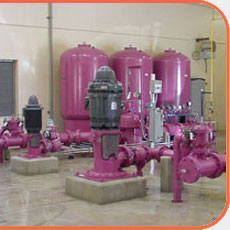Reusing retreated water generates savings for the city.

Different size pumps and tanks are needed to recirculate the reclaimed water depending on volume and how far it has to go
reusing treated water
Nearly all of the water that is reclaimed at the city’s Water Reclamation Plant is returned to the environment. A relatively small portion is pumped to one of three different areas for reuse. The pumps that take care of this are housed in the disinfection building.
There are three separate pumping systems in this building. All of them draw their water from treated plant effluent. (Effluent is the water flowing out of the plant and is the opposite of the raw sewage influent.)
non-potable water system
The non-potable water (NPW) system provides water for a number of uses throughout the plant that do not require potable (drinkable) water. These uses include water to clean the grit screens, dryer cooling water, and water used to wash down equipment in buildings and the plant yard.
The NPW pumping system consists of four vertical turbine pumps, three hydropneumatic tanks to maintain steady pressure over a wide range of flows, a strainer to eliminate extraneous material in the water, and surge relief/pressure relief valves. The NPW system runs at a pressure of around 75 psi and can deliver flows from 0 to 300 gallons per minute. The total in-plant NPW usage averages about 3.5 million gallons per month. This represents an estimated annual savings of more than $50,000 since processed water does not have to be purchased for these uses.
chlorination
Plant effluent used for the NPW system and the reclaimed water system must be chlorinated. No chlorine is added to the sludge thickener system. Chlorination is accomplished by pumping sodium hypochlorite solution into the pump discharge lines. The 15% sodium hypochlorite solution reacts with the effluent water to produce chlorine.
The concentrated sodium hypochlorite solution is stored in two 1,700 gallon polyethylene tanks. Each tank is about 6.5 feet in diameter and 10 feet tall. There are three separate sodium hypochlorite pump/control systems: one to transfer solution between the storage tanks or into a smaller 300 gallon tank known as a day tank, the second to pump solution from the day tank to the NPW system, and the third to pump solution from the day tank to the reclaimed water system.
heritage golf course reclaimed water system
This system provides irrigation water to Heritage Golf Course upon request. Normally, the golf course requires irrigation water during dry weather periods, from around May 1 to October 1.
This system consists of two vertical turbine pumps and a surge relief valve. There is room to install two additional pumps if there are additional customers needing large amounts of irrigation water.
Due to the elevation of the golf course and the length of the force main to it (about three miles), the reclaimed water system operates at a very high pressure of around 180 psi. The normal flow when the system is in operation is about 500,000 gallons per day.
Use of the reclaimed water allows the golf course to avoid purchasing higher-cost drinking water for irrigation.
Due to public health concerns, systems that provide treated effluent for irrigation are subject to close scrutiny by Ohio EPA. The city must at all times maintain a positive chlorine residual at the point of discharge to the golf course’s holding pond. The city is also required to do bacteriological sampling. Mason has been selling water to Heritage Club since 1995 and has as very successful track record. About $12,000 is recovered each year through this use of reclaimed water.
mason sports park reclaimed water system
Similar to the golf course system, a dedicated system pumps reclaimed water to the nearby Mason Sports Park to irrigate the ball fields. The water used is considered “Class A Effluent” because it incorporates additional treatment to make it suitable for irrigation. During dry periods, it is estimated that the city will save between $20,000 to $25,000 per year by not having to purchase treated drinking water for irrigation.
sludge thickener dilution water system
The sludge thickener dilution water system provides unchlorinated plant effluent to the gravity sludge thickener. The sludge thickener functions much like a miniature clarifier and is used to increase the solids content of the waste activated sludge from about 0.5 % to 2%. Studies have shown that the use of dilution water improves the performance of gravity thickeners. It also helps eliminate odors. The thickener dilution water system consists of two submersible pumps that each deliver approximately 500,000 gallons per day at low pressure. Allowance was made in the building design for future installation of a third pump if this additional capacity becomes necessary.
savings for the city
Compared to the 8.67 million gallons per day that the plant can process currently, these above uses of reclaimed water are small. But when the savings incurred by reusing this treated wastewater are added up, they produce a significant reduction in expenses for the city.
